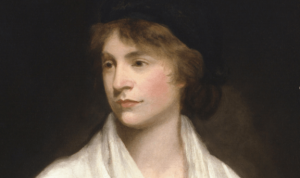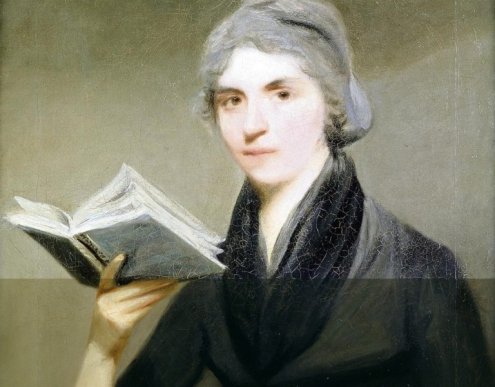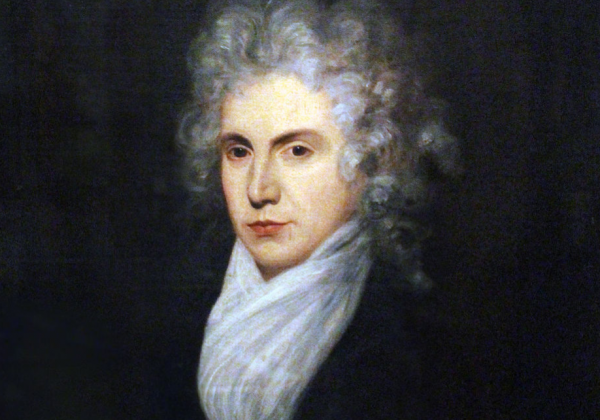Mary Wollstonecraft: The First Feminist

Back when feminism wasn’t as well-known as it is today, when women had no place outside the home, Mary Wollstonecraft trying to change that. The mother of Mary Shelley (who wrote Frankenstein), Mary Wollstonecraft, was a unique woman: a philosopher, writer, and the first feminist.
Unfortunately, Wollstonecraft was very controversial during her time, and many people criticized her ideas. She died not long after giving birth to her daughter, Mary Shelley, from an infection she contracted during the pregnancy.
After her death, her husband William Godwin (also a writer and philosopher) published her memoirs to try to keep her memory alive. In spite of his efforts, people still just remembered her for the controversy that surrounded her. None of the intellectuals of the time thought anything of her.
Virginia Woolf and other feminists of the time made a big effort to bring Wollstonecraft back because she was so misunderstood.
“My own sex, I hope, will excuse me, if I treat them like rational creatures, instead of flattering their fascinating graces, and viewing them as if they were in a state of perpetual childhood, unable to stand alone.”
-Mary Wollstonecraft-
Mary Wollstonecraft: The first feminist
Her early life
Mary Wollstonecraft was born on April 27th, 1759, in Spitalfields (London). Her family was economically well-off until her father threw away the entire family fortune. He also drank a lot and beat his wife. Mary always made sure to be a constant pillar of support for her sisters.
She also always argued for the independence of women and defied convention. So, she even advised her sister Eliza to abandon her family, but the world wasn’t prepared for that. It was an uncertain path to take back then.
Wollstonecraft had two very important childhood friends: Jane Arden and Fanny Blood. They both had a major influence on her life. Arden’s father was a philosopher, and Mary ended up following that path. Blood died after giving birth, which had a lasting impact on Mary.
Her adulthood
After Blood’s death, Mary made a major decision to become a writer. The first things she wrote about were the issues women faced in the worlds of education and work. When she tried to find a job, she ended up realizing that women only had two choices: to be a nanny or a governess. Women also got a much more limited education than men.

She did end up becoming a governess, although she gave the children a very unusual education. She wrote two books based on that experience: Thoughts on the Education of Daughters (1787) and Original Stories from Real Life (1788).
She wrote the first book in a style that was very common for that time period. What was unusual was that she wrote about single women and their lack of economic freedom. This wasn’t a perspective people expected to hear back then.
Later on, she got a job at a publishing house run by Joseph Johnson. There, she worked as a translator and ended up publishing A Vindication of the Rights of Men (1790). It was a response to Edmund Burke’s Reflections on the Revolution in France (1790).
In this book, she attacked inherited rights, the aristocracy, and defended the idea of a republic. But this controversial book was just a small taste of what would come later on…
Why do people consider Mary Wollstonecraft a feminist?
Mary Wollstonecraft left for Paris in 1792, during the chaotic time when Louis XVI was about to be executed by guillotine. Her life took a big turn there. She published A Vindication of the Rights of Woman (1792), fell madly in love with Gilbert Imlay, and had a child with him. However, she fell into a deep depression when the relationship didn’t work.
It was the 18th century, there were revolutions happening, and Wollstonecraft was a single mother. She tried to commit suicide when she went back to the UK.
Paradoxically, this strong woman who so fiercely defended her own rights and independence fell into a depression as a result of a romantic relationship. But even calling Mary Wollstonecraft a feminist is a bit tricky because the term didn’t exist at the time.
Still, if you read A Vindication of the Rights of Woman, you’ll realize that it’s an early call to action. What exactly did she criticize? For one thing, she felt romance novels made women seem like they had no thoughts of their own and were dependent on men. She also advocated for giving women the same rights as men, including education.
One of her big arguments was that women weren’t inferior by nature. She said that lack of education was a big part of that. This flew in the face of basically every other thinker from back then. But Wollstonecraft actually took things even further.
At one point, she suggested that painter and writer Henry Fuseli have an open relationship with her and his wife. But this was a time when polyamory was more than taboo, and this proposition had major consequences.

The end of her life
Mary Wollstonecraft had a hard time getting over her romantic disappointments. She wrote Fuseli endless letters and tried to commit suicide again.
In 1796, she published a book about some of her travels: Letters Written During a Short Residence in Sweden, Norway, and Denmark. She went on the trip to try to get Imlay back, but realized she had no chance.
In this book, she talks about many different social issues and her own identity and relationship with the world. Of course, she also argues for the freedom and education of women. Towards the end, she accepts that her relationship with Imlay is over.
Back in London, she met William Godwin, a writer and philosopher whose ideas were a precursor to anarchism. They got married and set up some rules to respect Wollstonecraft’s independence. This meant living in separate, but connected houses.
After her marriage, she began to write a lot again. Unfortunately, this happiness didn’t last. Mary died at the age of 38, not long after giving birth to her second daughter, Mary Shelley. Godwin raised both girls and remarried later on in life.
After her death
In 1978, Godwin published Memoirs of the Author of A Vindication of the Rights of Woman. But like we said earlier, people didn’t exactly like it. The book is a collection of some of her letters and other texts.
Nowadays, what she was saying sounds perfectly logical. But back then, it was controversial. The world apparently wasn’t ready for a woman like Mary Wollstonecraft.
Some people consider Mary Wollstonecraft the first feminist. In a way, she was, even though she wasn’t the first woman in history to demand rights. Feminism hadn’t truly started yet, but her books contain some of its earliest ideas, which nobody paid much attention to until the 1900s. It’s partly thanks to her that women are where they are today.
“Make women rational creatures, and free citizens, and they will quickly become good wives; – that is, if men do not neglect the duties of husbands and fathers.”
-Mary Wollstonecraft-
Back when feminism wasn’t as well-known as it is today, when women had no place outside the home, Mary Wollstonecraft trying to change that. The mother of Mary Shelley (who wrote Frankenstein), Mary Wollstonecraft, was a unique woman: a philosopher, writer, and the first feminist.
Unfortunately, Wollstonecraft was very controversial during her time, and many people criticized her ideas. She died not long after giving birth to her daughter, Mary Shelley, from an infection she contracted during the pregnancy.
After her death, her husband William Godwin (also a writer and philosopher) published her memoirs to try to keep her memory alive. In spite of his efforts, people still just remembered her for the controversy that surrounded her. None of the intellectuals of the time thought anything of her.
Virginia Woolf and other feminists of the time made a big effort to bring Wollstonecraft back because she was so misunderstood.
“My own sex, I hope, will excuse me, if I treat them like rational creatures, instead of flattering their fascinating graces, and viewing them as if they were in a state of perpetual childhood, unable to stand alone.”
-Mary Wollstonecraft-
Mary Wollstonecraft: The first feminist
Her early life
Mary Wollstonecraft was born on April 27th, 1759, in Spitalfields (London). Her family was economically well-off until her father threw away the entire family fortune. He also drank a lot and beat his wife. Mary always made sure to be a constant pillar of support for her sisters.
She also always argued for the independence of women and defied convention. So, she even advised her sister Eliza to abandon her family, but the world wasn’t prepared for that. It was an uncertain path to take back then.
Wollstonecraft had two very important childhood friends: Jane Arden and Fanny Blood. They both had a major influence on her life. Arden’s father was a philosopher, and Mary ended up following that path. Blood died after giving birth, which had a lasting impact on Mary.
Her adulthood
After Blood’s death, Mary made a major decision to become a writer. The first things she wrote about were the issues women faced in the worlds of education and work. When she tried to find a job, she ended up realizing that women only had two choices: to be a nanny or a governess. Women also got a much more limited education than men.

She did end up becoming a governess, although she gave the children a very unusual education. She wrote two books based on that experience: Thoughts on the Education of Daughters (1787) and Original Stories from Real Life (1788).
She wrote the first book in a style that was very common for that time period. What was unusual was that she wrote about single women and their lack of economic freedom. This wasn’t a perspective people expected to hear back then.
Later on, she got a job at a publishing house run by Joseph Johnson. There, she worked as a translator and ended up publishing A Vindication of the Rights of Men (1790). It was a response to Edmund Burke’s Reflections on the Revolution in France (1790).
In this book, she attacked inherited rights, the aristocracy, and defended the idea of a republic. But this controversial book was just a small taste of what would come later on…
Why do people consider Mary Wollstonecraft a feminist?
Mary Wollstonecraft left for Paris in 1792, during the chaotic time when Louis XVI was about to be executed by guillotine. Her life took a big turn there. She published A Vindication of the Rights of Woman (1792), fell madly in love with Gilbert Imlay, and had a child with him. However, she fell into a deep depression when the relationship didn’t work.
It was the 18th century, there were revolutions happening, and Wollstonecraft was a single mother. She tried to commit suicide when she went back to the UK.
Paradoxically, this strong woman who so fiercely defended her own rights and independence fell into a depression as a result of a romantic relationship. But even calling Mary Wollstonecraft a feminist is a bit tricky because the term didn’t exist at the time.
Still, if you read A Vindication of the Rights of Woman, you’ll realize that it’s an early call to action. What exactly did she criticize? For one thing, she felt romance novels made women seem like they had no thoughts of their own and were dependent on men. She also advocated for giving women the same rights as men, including education.
One of her big arguments was that women weren’t inferior by nature. She said that lack of education was a big part of that. This flew in the face of basically every other thinker from back then. But Wollstonecraft actually took things even further.
At one point, she suggested that painter and writer Henry Fuseli have an open relationship with her and his wife. But this was a time when polyamory was more than taboo, and this proposition had major consequences.

The end of her life
Mary Wollstonecraft had a hard time getting over her romantic disappointments. She wrote Fuseli endless letters and tried to commit suicide again.
In 1796, she published a book about some of her travels: Letters Written During a Short Residence in Sweden, Norway, and Denmark. She went on the trip to try to get Imlay back, but realized she had no chance.
In this book, she talks about many different social issues and her own identity and relationship with the world. Of course, she also argues for the freedom and education of women. Towards the end, she accepts that her relationship with Imlay is over.
Back in London, she met William Godwin, a writer and philosopher whose ideas were a precursor to anarchism. They got married and set up some rules to respect Wollstonecraft’s independence. This meant living in separate, but connected houses.
After her marriage, she began to write a lot again. Unfortunately, this happiness didn’t last. Mary died at the age of 38, not long after giving birth to her second daughter, Mary Shelley. Godwin raised both girls and remarried later on in life.
After her death
In 1978, Godwin published Memoirs of the Author of A Vindication of the Rights of Woman. But like we said earlier, people didn’t exactly like it. The book is a collection of some of her letters and other texts.
Nowadays, what she was saying sounds perfectly logical. But back then, it was controversial. The world apparently wasn’t ready for a woman like Mary Wollstonecraft.
Some people consider Mary Wollstonecraft the first feminist. In a way, she was, even though she wasn’t the first woman in history to demand rights. Feminism hadn’t truly started yet, but her books contain some of its earliest ideas, which nobody paid much attention to until the 1900s. It’s partly thanks to her that women are where they are today.
“Make women rational creatures, and free citizens, and they will quickly become good wives; – that is, if men do not neglect the duties of husbands and fathers.”
-Mary Wollstonecraft-
This text is provided for informational purposes only and does not replace consultation with a professional. If in doubt, consult your specialist.







